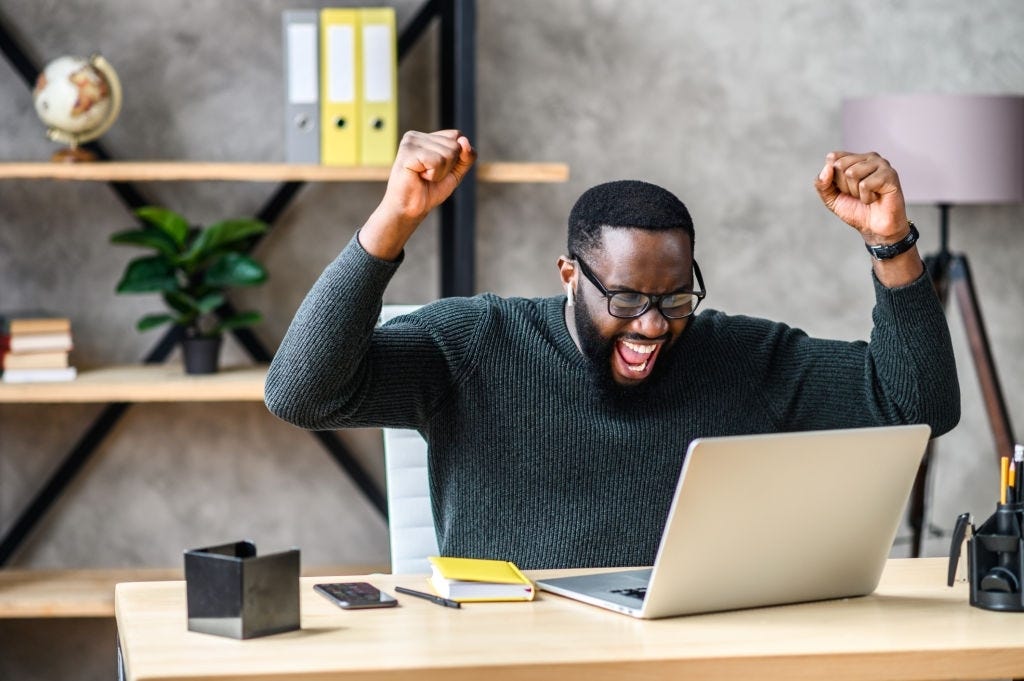
To land a flexible, remote job that pays well, you need to learn the right skills, improve your CV and cover letter, boost your online visibility, join the right communities, apply incessantly, and prepare for interviews.
You also need to ensure you can get paid for your work no matter where you’re located in the world.
Learn the right skills
With remote working, certain skills are more lucrative and in demand than others.
A bricklayer can’t work remotely, but a software engineer can work from anywhere in the world – and get paid a lot more.

To leverage this fact, you have two choices:
- Learn the lucrative, in-demand skills that will bring you the money and lifestyle you want; or
- Scan your current industry for roles that you can do remotely
#1 is pretty easy to do – there are plenty of well-paying skills currently experiencing high demand. These include:
- Writing (copywriting, email marketing, blog writing, etc.)
- Design (UX/UI design, graphic design, video editing, etc.)
- Social media (content creation and scheduling, paid ads and analytics, influencer marketing, etc.)
- Software (full-stack engineering, data science, QA & testing, etc.)
- HR (recruiting, training, wellness, etc.)
- Customer support (live chat or web support, community management, etc.)
You can learn these skills from places like YouTube, Codecademy, Khan Academy, Skillshare, and more.
#2 is more suitable if you don’t want to leave your field. Let’s say you work in hospitality.
Certain aspects of the industry require physical presence: cooking, cleaning, restaurant management, delivery, and more.
But there are other aspects that you can do remotely, like marketing restaurants, offering customer support for hotels, coding hospitality apps, and recruiting staff.
The key is to find what you enjoy, that pays well, and that you can do remotely. You’ll need to search harder for remote jobs in that specific niche, but they exist.
You can also speak to your current or prospective employer and ask if they’re open to a remote working arrangement.
Gain experience
Learning the right skills is just the first step – you still need to gain enough experience before employers and potential clients can take you seriously.
This is where building a portfolio comes in. You’ll need to show that you’ve worked on similar projects in the past, and you can do this by simply working on free or paid gigs for friends, family, and colleagues in the beginning.
Yes, it’ll be challenging and most likely unpaid, but it’s worth it. Try and negotiate lower rates (or payment in kind) when doing these portfolio-building gigs.
Examples:
- Manage the social media presence of a friend launching their business.
- Intern at a software development shop for a few months to learn all the frameworks, languages, and insider tricks.
- Create voiceovers for local businesses if you have a great voice.
You don’t need to have an extensive portfolio: 6-10 good pieces are enough. Just make sure those pieces are your best work because competition is tight for remote jobs and you need projects that cast you in the best possible light.
Improve your CV and cover letter
Your CV is critical to landing a remote job. Hiring managers see hundreds of CVs a day, so they seek first to disqualify you before properly assessing your CV. Don’t give them any reason to chuck yours out of the pile.
Here’s how you can improve your CV:
- Keep it short and sweet – one-page max. Yes, everything can fit on one page. Add a link to your LinkedIn profile so people can always see the latest version of your employment history.
- Remove unnecessary info like your physical address, driver’s license number and postal address. It’s a remote job — the only thing they need is your name and email address. You can give them all that other stuff when you get the job. Also, remove anything related to high school — nobody cares where you matriculated.
- Include links to your website, portfolio, and social media profiles where appropriate.
- Keep your CV relevant to the types of jobs you’re applying for. If you’re applying for a management position in your sector, nobody cares that you were a waitress for two months in 2011… unless you’re applying for a hospitality job.
- Keep it simple design-wise, label each section clearly, and avoid fancy fonts. Most importantly, include the keywords most commonly used in job descriptions in your field to avoid getting disqualified by applicant tracking systems.
For example, suppose you’re applying for content writing roles. In that case, many of the job descriptions will include role-specific words and phrases such as ‘creating content,’ ‘topic research,’ ‘editing,’ ‘SEO,’ and ‘promotion and outreach.’
Including those words improves your chances of making it past the ATS and catching the eye of the hiring manager.
Your cover letter is another crucial piece of your application. Many of the same rules apply: avoid generic templates, be concise (one page), talk about relevant experience, and show some personality.
Your cover letter is your chance to shine and show them why they should pick you over the other 537 candidates who applied.
You only have one shot at getting it right.
Improve your online visibility
There’s no point gaining skills and experience if nobody can find you. Improving your online visibility exposes you to potential employers and clients across different platforms, and your online profile works for you 24/7.
There are three aspects to your online visibility: your website, social media channels, and content.
Website
Your website is your online home — it’s where your content, portfolio, CV, social media links, and contact details live.
A good website indicates your commitment to your craft and speaks for you in your absence.
You don’t need to pay thousands for a fancy website, either — just find a nice WordPress, Wix, Webflow, or Squarespace template and tweak it to your liking.
Use a URL that’s easy to remember and unique to you. For example, my website URL is mohammedshehu.com.
If you’re a copywriter in Johannesburg, you can use jhbcopywriter.com. Play around with different ideas until you find one that works.
For consistency, use a site like namecheckr.com to find a username and URL combo that’s available across all major channels.
Social media
Your social media presence is an extension of your personal brand. Employers scan your social media profiles for two things:
- Commitment to your craft (do you post about your job? Industry news? Tips and tricks?)
- Risky content that may harm their brand or yours (hateful comments and posts, lewd content, etc.).
But before all that, it’s essential to have a presence on the right platforms.
To land remote jobs, LinkedIn is non-negotiable — most remote job application forms will ask you for your LinkedIn URL.
Beyond LinkedIn, you can choose to have a presence on Twitter, Instagram, Facebook, Pinterest, TikTok, and other channels, depending on the types of jobs you’re applying for.
For example, if you’d like to work remotely as a graphic designer, you’ll need a profile on LinkedIn and Behance, and maybe another one on Dribbble, Instagram, or Pinterest.
If you can build a following on Facebook (through a Page), that works in your favor.
But merely having an account on these pages won’t land you the jobs you seek. It’s also essential to connect with the right people on those platforms.
For instance, if you’ve just created a LinkedIn account as a graphic designer, connect and engage with creative directors, marketing managers, club owners, and other key people who are most likely to book your services or hire you to work at their companies.
Curate your feed selfishly — make sure every new connection is someone who adds value to your career or business or someone you can add value to.
Content
Content isn’t king; it’s the whole kingdom.
Your content forms part of your CV, and the type of content you create (and how consistently you create it) determines whether or not people will trust you enough with their projects and money.
There are plenty of guides online to creating content, but here’s a rough guide:
- Document what you’re doing. Working with a new client? Post about it. Learning a new skill? Share your learnings as you go along. When you get into the habit of documenting what you’re doing, content creation becomes exponentially easier.
- Share industry news that’s relevant to your audience. What’s happening in your industry right now? What are the implications of those events? How do you feel about them? Sharing current events helps you build credibility.
- Share what your peers are doing or seeking. Did another graphic designer just finish a new piece? Share their post. Is a writer in your circle looking for work? Share their #opentowork post on LinkedIn. A little goodwill today can bring you potential business tomorrow.
Mix up your content formats: post text, images, videos, GIFs, and even audio on sites like Twitter and Clubhouse.
I highly recommend experimenting with Stories and Statuses (depending on what platforms you’re on), as those can spark interesting conversations in your DMs.
Join the right communities
While you’re working on your online profile and portfolio, take some time to join the right communities in your field.
This is one of the highest-leverage activities you can do, as it will give you first access to all the best jobs in your industry.
People hire from within their networks first, so if you’re not in those networks, you’ve already lost.
Certain professions lend themselves better to forming online communities than others (like marketing, sales, and software development), but every profession has a place where its members congregate.
Find those places, join them, and engage with the people within.
For example, marketers hang out a lot on Clubhouse, Twitter, and Slack.
You can join popular Clubhouse rooms on marketing, follow relevant #marketingtwitter conversations, and join Slack communities of other marketers like Superpath (for content marketers).
Salespeople hang out a lot on Facebook Groups and Slack communities, so join groups like BAMF on Facebook or RevGenius on Slack.
Developers have entire Slack communities dedicated to them and their different languages and frameworks, so join the ones that appeal most to you.
Your results are directly related to your effort in those communities, so make it a point to create content, not just consume it.
People remember those who frequently comment and post in these groups and are more willing to contact them first when there’s a new opportunity.
Apply incessantly
Applying for remote jobs is a numbers game. There are hundreds of you applying for the same positions, so the only control you have over the application process is your profile (website, socials, content, CV) and consistency.
If you’ve done the first part well, the second part should be a breeze.
There are plenty of online remote job boards that you can subscribe to for regular job vacancies. These include:
- WeWorkRemotely
- JustRemote
- ContentWritingJobs (for writers and content creators)
- Angel List
- Remotive
- RemoteOK
- Work In Startups
- GitHubJobs
- Flexjobs
- Arc (for developers)
A simple Google search will turn up even more sites to check out, but the above sites are great starting points.
You’ll notice I’ve left out sites like Fiverr and Upwork.
This is because while there are freelancers making decent incomes on those platforms, competition is much higher for relatively lower pay.
Rather use that energy to build up your online profile and apply for higher-paying jobs.
Can’t find job boards for your niche? Create one to fill that gap.
If you know a little bit about web design, marketing, and social media, you can create a platform for jobs in your field and charge companies to advertise their open roles on it.
These companies currently pay anywhere from $49 to $299 for job postings, and not only will that give you first access to all the best jobs in your industry, but you’ll likely end up making so much money that you won’t need a remote job anymore.
It’ll take you some time, effort, and money to populate your job board and build up an audience, but it pays off handsomely in the long run.
Track every job application in a spreadsheet like this one.
It’ll help you know the progress of each application is, how much the job is worth, and what to expect next.
It’ll also let you know if you’re applying enough — because job-hunting is a full-time job. Aim for at least 50 targeted job applications each month.
Prepare for interviews
If you’ve been lucky enough to get a positive response to your application, congratulations!
You’ve likely beaten out hundreds of other applicants for that role, which means you’re doing something right.
You’re still far from a signed offer letter, though, so your work has just begun.
Most companies have elimination rounds before you get to the actual interview.
They may ask you to work on a sample project, do a presentation, or analyze an existing asset and share a report.
You might feel that this is a lot of free work for a job you don’t yet have. Don’t think that way.
Why? Because everything can be turned into content.
If you work on a sample project for a company you’re interviewing with, you can discuss that on your social media pages or in your newsletter.
If you assess and report on a company’s assets (like their website or app), you can add that analysis to your portfolio.
It is, after all, something you did — whether you got paid for it or not.
And each new addition to your portfolio strengthens your chances of landing the next job you apply for.
If they say you can’t post your work or analysis anywhere else (e.g., by making you sign an NDA), then that’s grounds for payment. Send them an invoice before you start the work.
Once you’ve passed the test(s), there might be several rounds of interviews to get through.
You’ll likely talk to the recruiter first, who will do a first pass on your experience and background.
After that, you might speak to the hiring manager, CEO, and some of your future colleagues.
All the standard rules of a job interview apply here, plus a few extra ones specific to remote job interviews:
- Come prepared. Learn about the company, product, and co-workers in advance — use LinkedIn for the latter.
- Check your equipment. Ensure you have a fast internet connection (or lots of mobile data), a working webcam, and a clear mic. While most employers will forgive minor hiccups during a remote call, it sends a better message when you come prepared. If you know your home connection is likely to drop during an interview, head to the nearest wifi-enabled cafe or coworking space to do the interview, or use mobile data for the call.
- Arrive on time. A late arrival sends the wrong message. Communicate in advance if you’re going to be a few minutes late.
- Take lots of notes, and bring prepared notes if you need to. A remote interview means you can jot down notes and refer to them when necessary. And no, bringing notes to an interview is not illegal — you’re not in high school anymore. Nobody expects you to memorize every detail of your past working experience.
- Ask questions so you know what you’re walking into. What kind of resources will you work with? Who will you be working with, and what would improve the working relationship between you and them? How often does the company do performance reviews, and what would success look like in 6-12 months? What are the growth prospects for the role? Why did the last person get fired? (so you know what mistakes to avoid). Curiosity scores you brownie points and helps you decide whether the job is worth it.
Get paid
There are two aspects to getting paid for remote work: negotiating your pay and choosing the best payment method(s).
There are many guides online on how to negotiate your salary. I won’t repeat the tips here, but suffice to say that your target salary should always make you slightly uncomfortable.
This ensures you’re not lowballing yourself and gives you room to negotiate if they can’t afford your initial rate.
Mohammed Shehu, PhD @ShehuPHDYou don’t get what you deserve; you get what you negotiate.January 25th 20212 Retweets3 Likes
You might be tempted to take the first offer they give you. Don’t do it.
Unless they have a transparent salary calculator (like PostHog does), it’ll be up to you to decide how much you want to get paid and up to them to decide whether they can afford you.
You can benchmark your ideal salary by looking at other vacancies for the same role and adjusting the numbers depending on your experience, the scope of work, and the expected value you’ll bring to the company.
Remote work also means getting paid in different ways by different clients and employers. There are three main ways to get paid online:
- Through PayPal or some other payment platform like Payoneer, Skrill, or TransferWise. Create accounts on all these platforms so you’re always ready to receive payments.
- Via Electronic Fund Transfer (EFT), also known as a digital bank payment. Always indicate your bank details (including your address and SWIFT code) on all invoices.
- Through an Employer of Record or remote employment platform such as Deel or Rippling, which then pays it to you. You typically have to sign up for an account on the platform your employer or client uses.
Unless you reside in the same country as your prospective employer or one of their subsidiaries, remote companies will typically pay you a lump sum each month covering your salary and benefits (if any).
It’ll be up to you to handle your taxes, medical aid, and insurance. Speak to a certified financial advisor in your country for further guidance.
Find a remote job today
Remote working offers flexibility and, in many cases, a lot more money than a local job does.
Competition is high for these roles, however, so do everything you can to improve your chances of landing a well-paying gig.
Follow the above steps to get started today.
Connect with me on LinkedIn and Twitter for more advice on remote working, running a business, and growing your brand.
This post was originally published on my newsletter.

Mohammed Shehu, Ph.D. writes on content and marketing for creators and brands. You can find him online @shehuphd everywhere.

